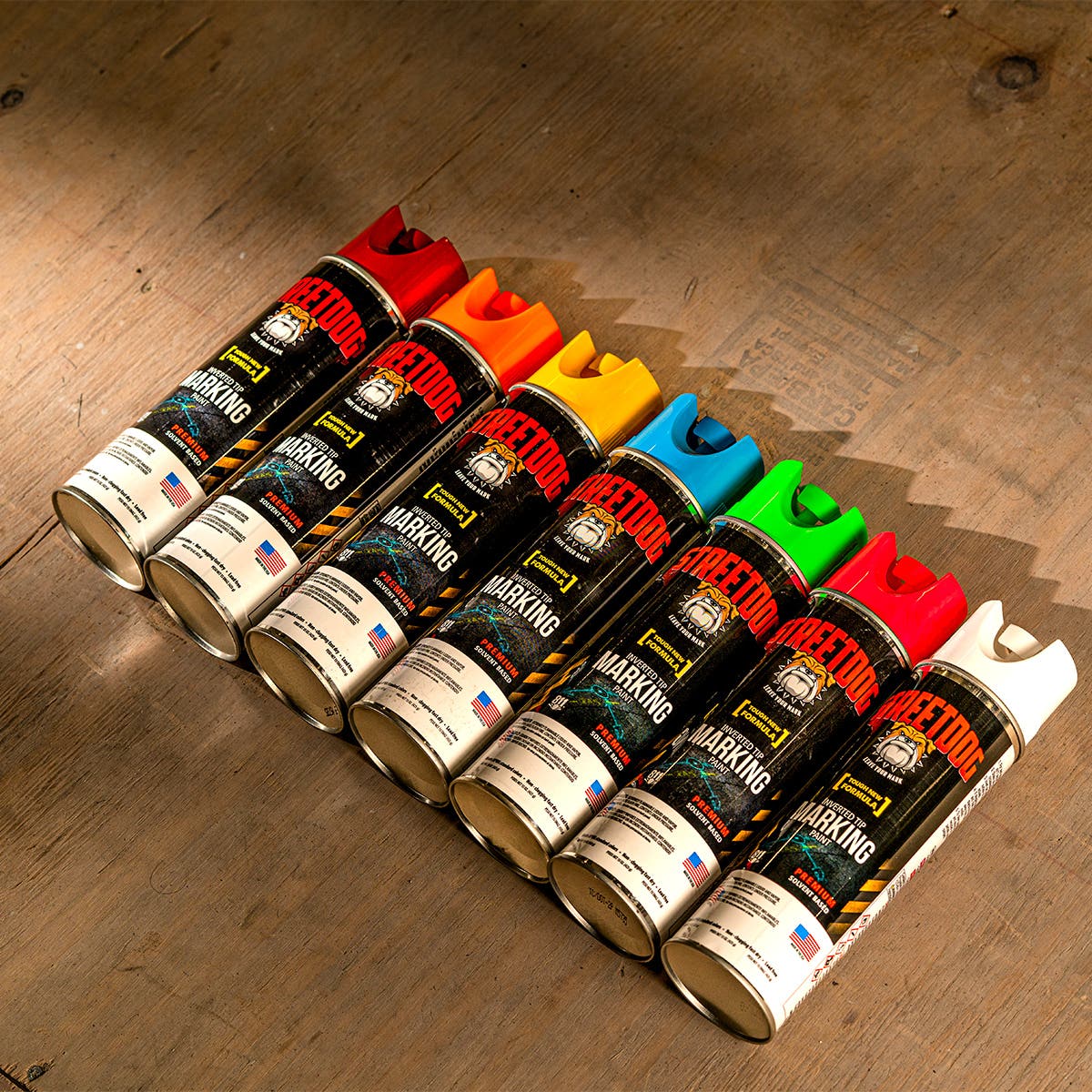*Disclaimer*
The information contained on this page is for promotional and informational purposes only. All equipment should be used by trained professional tradesmen who have been trained how to use the equipment described on this page, and understand the risks of their work. PowerPak assumes no responsibility for errors or omissions in the use or misuse of any product purchased. In no event shall PowerPak be liable for any direct, special, indirect, consequential, or incidental damages or any damages whatsoever, whether in an action of contract, negligence or other torts, arising out of or in connection with the use of this information or the contents of this page. PowerPak reserves the right to make additions, deletions, or modifications to the contents on this page at any time without prior notice.
Table of Contents
Utility markings are everywhere. You see them on sidewalks, in the street, even in your backyard. They are a combination of colors, lines, shapes, arrows, and words that you’ve likely seen so often that you no longer notice them.
The sole purpose of utility markings is to efficiently provide information on buried utilities like power lines and sewers so that construction crews don't excavate, dig, or drill into them, causing damage, outages, and hazards.
This form of communication between utility companies and construction crews has proven to be very effective when used correctly. Utility markings need to be requested by individuals or construction companies before breaking ground. When this step is skipped, workers are put at increased risk of injury or death.
But how is this communication system all organized, and how do the construction crews decode the markings? We are going to dive in and find out.


Why Are There Utility Markings On the Street?
The number one reason why the utility marking system was created and used today is not for damage prevention; it saves lives. Hitting a utility while excavating puts workers and civilian lives at risk. An example of this occurred in the late 70s in California, when a construction crew tasked with a street widening project struck a petroleum pipeline. This accident resulted in a massive explosion that the L.A. times described as a “wall of flames” that destroyed a block of businesses, killing nine people.This incident, along with many others, prompted The American Public Works Association (APWA) to create a national color-coded utility marking system to help inform workers and prevent accidents like this.
The Use of Marking Paint
Marking paint is mainly used for teams to know what lies beneath the ground. It's one thing to have sets of diagrams, maps, and blueprints to work with from different utilities and local governments. Sure, there's plenty of information, but it can be hard to visualize. By marking these utilities out on the grass or asphalt of a proposed site, design teams, excavators, and construction teams can figure out just what hazards lay below.

Not all marking paint signals an underground utility. Some have other meanings. So how do we keep the colors straight, and how do we avoid confusing what they may mean?


What Are the Color Codes for Utility Markings?
The American Public Works Association (APWA) sets forth a list of Uniform Color Codes to mark underground infrastructure. Whether you are working on a site in New York City, New Jersey, Pennsylvania, or Seattle, or have even been contracted to do a job in Nebraska or Oregon, the colors mean the same thing. Having a nationally uniform code eliminates confusion if the marking team or the working crews are from different areas.Red – There's no coincidence that the universal color that indicates "stop" or "danger" marks electric power lines, cables, conduit, and lighting cables.
Orange – This signals telecommunication, alarm, or signal lines, cables, and conduit. This could also include fiber optics and more. As reliant as we are on communication these days, this can be an incredibly dangerous marking to miss.
Yellow – One of the brightest markings, and for good reason. This marking paint indicates that what is underneath is natural gas lines, oil, steam, petroleum, or other gaseous or flammable material. Proceed with urgency. Not many folks get a second chance if they ignore yellow paint markings.
Blue – Potable (drinkable) water. It makes sense that they would use blue for this, doesn't it? Hitting these could disrupt an area's drinking water.
Purple – Non-potable water, including reclaimed water, irrigation water, and slurry lines. Hitting these, while it wouldn’t hurt the drinking water supply of an area, would create a swampy site and still disrupt work and life around the site.
Green – Sewer lines and drain lines. While the consequences to the project of hitting this may not be as bad as hitting a potable water line, no one wants to be known as the person who cracked open a pipe and let sewage onto a site. Green does not mean go, in this case.
White – Proposed excavation areas or routes that show where digging is proposed.
Pink – Temporary survey markings indicating the legal boundaries that affect the project.
While the latter two do not indicate any potential buried problems, they should still be heeded. In fact, you've probably used our white marking paint on some of your own sites to indicate instructions to your team. You've probably also come across the pink markings on a surveyed site in your planning stages.
What Do Common Utility Markings Mean?
The color code only gets you halfway there. Trying to understand the actual utility marking and symbols is a daunting task. At first glance, they look like an entirely different language, but getting a general idea is not that hard.It will help if you start by understanding what a construction or excavation crew needs to know before digging. They need to know:
What type of utilities are buried below? The color system mentioned in the previous section provides this information. As mentioned, the color code system is nationally implemented, so no matter where you are in the U.S., red marking paint means “electrical power utility”.
The markings themselves indicate where the utility is buried; these markings aren't 100% accurate. Different states and utility companies have different rules, but a general rule of thumb is not to dig, drill, or excavate within 18”-24” of the edge of the marking, this is known as the tolerance zone. In New York, the law requires a minimum of a two-foot tolerance zone.
The width of the utility can be indicated in a couple of different ways.
You may see a single line that has the width written out. The marking line indicates the center of the utility. In this case, the written width needs to be added to the tolerance zone. So, if you see that the width is 8", you cannot dig within 28" of either side of the line (24" tolerance zone + 4" width on each side = 28" new tolerance zone)
Another way the width can be indicated is by two parallel lines that are connected with a straight line, like an "H", or sometimes a diamond shape, indicating a conduit or duct. The distance between the parallel lines is the width of the buried utility.
The depth of the line or facility will be written out near the marking.
An arrow on the marking line indicates the direction of flow.
You'll also see the utility company's name or owner of the underground facility. This is usually abbreviated. An example is New York, CON is Con Edison, and NG is National Grid.
Understanding these basics will help you decode a lot of the markings you see all over the place.
The Importance of Marking Paint
Beyond that, the design team can consider any needed change by marking out the known utilities and underground features. In particular, engineers and architects pay attention to these markings, as they can change how they shape and position building elements to fit with existing infrastructure and utility.
Reviewing the utility markings during the planning phase saves money. It allows the opportunity to move elements that could disturb existing utilities and prevent costly rerouting mid-project.
And yes, you need utility markings before planting plants. Planners and landscape architects will also use these markings to figure out how to position irrigation systems, walkways, parking areas, flora, and much more. Some utilities are buried very shallowly and could be struck while digging out a simple flower bed.
Work Safely and Efficiently With PowerPak Supplies
If you see these markings, take heed because something important is buried underneath. Don't cover them up or try and wash them away.If you are prepping for an excavation, call 811 or visit call811.com. Be sure to give yourself enough lead time. The process can take days to weeks to get all utilities properly marked.
When you're looking to put down your own markings, whether you are an electrical team mapping outlines, or an excavation contractor preparing the site for digging, make sure you use durable, easy-to-see marking paint.
PowerPak offers a variety of options. We carry inverted spray paint cans in all of the APWA approved colors under our own brand STREETDOG, always in stock and ready to ship. It is fast drying, works in low temperatures, and has a non-clog tip. You can make the job even easier with a 34” paint applicator wand.









